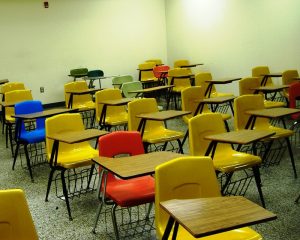 Hurricane Katrina, which happened in 2005, wreaked havoc across the Gulf Coast, claiming the lives of more than 1,800 people. In the aftermath of the storm, more than 372,000 children had been displaced. Over 100 public schools were destroyed, and those that still stood were shut for weeks.
Hurricane Katrina, which happened in 2005, wreaked havoc across the Gulf Coast, claiming the lives of more than 1,800 people. In the aftermath of the storm, more than 372,000 children had been displaced. Over 100 public schools were destroyed, and those that still stood were shut for weeks.
Effects of Lockdown on Children
While the displaced children did find new schools after the floodwater receded, the impact of the flood and the subsequent time away from school still lingered. Some children exhibited signs of depression, post-traumatic stress disorder, and anxiety long after the disaster. Five years after the disaster, studies showed that more than a third of the affected children still lagged behind their peers academically.
At face value, you might think that a natural catastrophe has little in common with a viral pandemic. However, with more than 1.3 billion school-going children around the world staying at home, Hurricane Katrina can provide researchers, parents, and policymakers with ample insights into how coronavirus shutdown will impact our children in the long-run.
The initial deduction does not bode well for our children. Studies on the after-effects of earthquakes, storms, and disease outbreaks have shown that disasters have the potential to cause negative impacts on children’s mental health and academic growth. The director of the Jack Brockhoff Child Health and Wellbeing Program, University of Melbourne’s, Lisa Gibbs says that while the specific characteristics of hazards are crucial with regards to recovery experience, the overall human impact remains quite consistent.
How Schools Are Coping
During lockdowns, many schools, including schools for the disabled, have adopted the policy of long-distance learning with teachers providing materials through online portals, for instance, Google Classroom or holding classes through platforms such as Zoom and YouTube. Nonetheless, there have been mixed results as far as substituting in-person classes with direct online classes is concerned. Unfortunately, the widespread use of distance learning will likely exacerbate a pattern well established in natural disasters – children from economically disadvantaged backgrounds will suffer the most.
It is also difficult to know how much every child is learning during online classes. According to a survey conducted on the teacher polling app, Sutton Trust and Teacher Tapp, private school students in the UK are twice as likely to access online classes every day compared to state school students. In the same vein, working-class students are spending far less time studying during the lockdown and, therefore, they have experienced a significant drop off in the quality of academic work.
Teacher Tapp’s co-founder, Laura Mclnerney, says that their data shows that 55% of teachers among the most disadvantaged schools believe that their students were getting about an hour of education per day. Private schools, on the other hand, were more likely to use online learning tools even before the outbreak of the pandemic. Wealthier students are more likely to own their devices, ample studying space, and a reliable internet connection to use for studies. Mclnerney reckons that half of the private school students are accessing nine-to-three online classes on school days while less than 10% of state schools are accessing nine-to-three classes.
At the time of publishing this article, schools in countries such as France, Germany, and China are starting to reopen. The government says it hopes to reopen school from 1 June for students in certain ages as long as they meet the reopening criteria. Many other countries such as Wales and Scotland do not have a clear timetable for a return to school. However, schools in California, New York, Portugal, and Italy are to remain closed until September.
Hope for the Future
Gibbs, who advises governments on post-disaster planning, usually recommends the development of a 5-year recovery plan. To recover from coronavirus, however, it is more likely that the recovery will take longer, especially if the pandemic drags the world into another recession. That said, while studies from disaster research appear to be bleak, Gibbs reckons the overall message is one of hope. Despite the toll of disaster, most children from calamities will recover and, eventually, go on to live normal, happy, and fulfilling lives.
